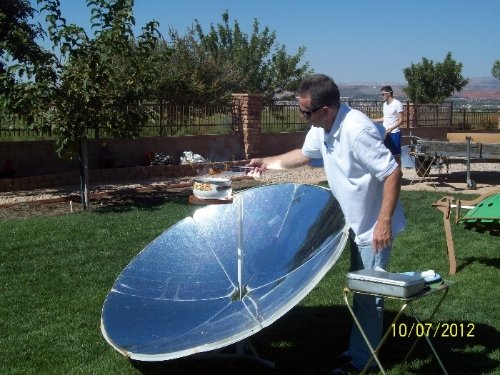Using A Solar Oven More Effectively
The results are amazing when using a solar oven most effectively and efficiently. In fact, it will allow one to cook anything you can cook with a standard home oven or stove top.
This page is designed with the intent to help solar cooks everywhere become more proficient and more effective with their own solar cookers, even with those home made solar ovens.
We have decided to use the top four commercial solar ovens as our models of example, but the ideas, tips and techniques can be applied when using any solar oven or cooker.
 |
Share your own tips, ideas, hints on using a solar oven and how you got the most out of your solar cooker, whether homemade or commercial |
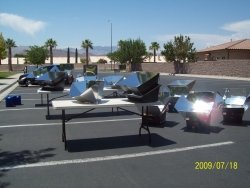
Awesome display of Solar Cooking Power?
Using a Solar Oven: The Hot Pot
The Hot Pot is a great little panel cooker, designed through a scientific approach to solar cooking by using high quality and high tech materials, and getting all of the reflector panel's angles just right for maximum solar energy concentration; resulting in very efficient and effective cooking results.
But, having said all of that, the Hot Pot is not the most ideal solar cooker for baking foods such as cookies, breads, cakes etc., although you can do some baking.
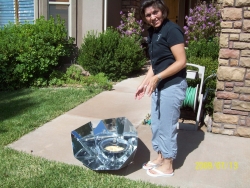
What can the Hot Pot cook then?
Name any food outside of baked goods and the Hot Pot can cook it; and very well at that.
(* A note though, for solar cooks in the Northern Hemisphere or those above the 20th parallel, a panel cooker can be a little less effective in the winter time because the sun has moved farther south into the southern horizon, causing the rays of the sun to be less direct, thus less intense and more filtered by the atmosphere. But this can be overcome by flipping the panels on their side, giving a steeper angle to capture the sun).
We would like to share some of the things we have noted when using our Hot Pots for cooking, by sharing what has worked well and what has not worked quite so well.
First of all, anything with a high liquid or moisture content does very well in the Hot Pot, especially when allowed to slow cook in similar fashion to a crock pot cooker.
Soups, stews, chilies, roasts, chickens and vegetables do nicely in the Hot Pot.
We have also been able to cook up rice, wheat, dry beans, lentils and other foods that need high amounts of liquid. Along with those we have had much success in cooking most every kind of pasta as well as corn on the cob, banana squash and hard boiled eggs (no water necessary) to name a few.
Tips for most effective use of your… Hot Pot
- Always keep your pot and reflector panels free of dust, stains, spills etc for more effective cooking results and longer life for your cooker.
- Uncover the cooking food in your pot as little as possible to avoid losing heat and increasing cooking time. Panel cookers take a bit longer to recoup the lost heat.
- Remember that a panel cooker is a bit less effective in the late fall to early spring months here in the northern hemisphere due to the low southern sky position of the sun during this time, although it can still be used effectively enough if adjusted to a greater angle (inclined) and used during prime sunshine hours. This can be most effectively accomplished by gently flipping the panels on their side, which gives it the greatest angle for capturing low horizon sun light
- When boiling foods such as corn on the cob, potatoes, pasta etc. it is helpful to pre boil your water a few hours ahead of actual food cooking time. For example we will fill the pot with four to six cups of water and allow it time (3-4 hours) to reach boiling point and then we will add the dry pasta about a half an hour before we are ready to eat; the pasta cooking within about twenty to thirty minutes, depending on amount.
- Eggs can be hard boiled without any water at all. Just place a few eggs carefully into the Hot Pot and then set the covered pot into the reflector panel and aim it at the sun. * We hard boil a dozen eggs in about an hour's time on a good day. (When the eggs have formed small brown spots on the outer shell, this usually indicates that they are finished. It doesn't hurt them if you happen to leave them longer)
- Vegetables such as broccoli, cauliflower, carrots etc. can be cooked in the Hot Pot using very little water or none at all. The vegetables usually cook with their own moisture content. *Be careful not to leave them longer than necessary, whereas you can overcook them and dry them out.
- The Hot Pot is great at baking potatoes, just scrub them clean and place them in the cooker. Depending upon the amount of potatoes; it will determine how long you need to cook them. Test them with a fork after about an hour to two hours.
- When your Hot Pot is not being used for cooking a meal, why not put it to work boiling water for many other household and meal uses as well as cooking up a batch of dry beans all day long,then store them in freezer bags for later use in recipes where needed. Boil up a batch of whole grain wheat for use in foods and recipes that could use some "bulking up" making them more substantial and filling.
- The hot pot is great for boiling up some herbal teas, hot drinks of any kind. We use ours also to re-heat leftovers from the days before, or to throw in some hot dogs or sausages an hour before going to the park or hiking, and then picking it up, taking it to the park and setting it in the sun again to finish cooking that day's picnic lunch.
For tips, suggestions and help using your Hot Pot
Using a solar oven: The Sport Oven
The SOS Sport is a very easy to use, very effective solar oven, designed with succulent and moist slow cooking in mind as well as roasting and baking.
The Sport will usually register slightly lower temperatures than its main competitor, the Global Sun Oven, but when it comes to cooking results, most of the time the results are almost indistinguishable.
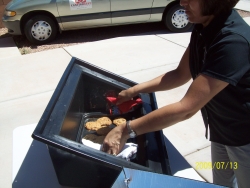
For example; when baking two bread loaves at a time, white or wheat, the Sport is not too far behind the Sun Oven which will bake two loaves in about an hour, and the Sport is usually about fifteen to twenty minutes longer.
The Sport is a wider oven and therefore can fit standard size cake pans and cookie sheets, as well as the two roasting pots that come with the oven.
Of course when there is more mass (food) inside of the oven, one must allow more time to cook no matter which kind of solar cooker one uses.
Cakes, pies, casseroles, meats, soups, stews, chili, pasta, sauces etc. etc. are all effectively cooked using the Sport Solar Oven.
Tips for most effective use of your… Sport Solar Oven
- When baking with the Sport, best results are obtained when you can preheat the oven to the highest temperature possible, nevertheless cakes, breads and cookies finish well within the time and ranges of other major solar ovens even if the temperatures do not always reach 300 F plus in the Sport.
- In the fall through winter and early spring you can use the Sport in its "winter angle" by setting it on its (narrower)side and with the reflector panels attached, thus achieving a more direct sun angle. (* The interior oven space for regular sized pots is reduced when using this angle, thus requiring smaller cooking vessels.)
- If you want to use the Sport in the winter, in its regular standard cooking mode for larger pot capacity, you can increase the angle of the oven and panels for more direct sunlight by placing supports (blocks, stones) underneath the solar oven, thus creating a greater more effective cooking angle.
- When using the Sport in mid summer it is not necessary to always use the reflector panels after the food within your oven has reached its maximum sustained cooking temperature. By taking off the panels in mid summer you will reduce the risk of overheating the oven frame (box) and possible warping of the box.
- * * Do not clean the inside or outside of the lexan lid, (cover) with glass cleaner. Damage to the lexan will result. Use warm water with a drop of dish detergent to clean the lid as well as the interior of the oven when needed.
- Clean the interior of your oven periodically with hot, soapy water to eliminate the buildup of food smells and residue from the food condensation. Do this even if you do not spill anything in your oven interior.
- At times, it can help to add (using clips) small "booster" reflective panels to your Sport to increase the temperature more quickly or to help it to maintain a higher overall cooking temperature. You can do this by using cut to size sections of lightweight Reflectix brand reflective insulation, acquired at your home improvement/hardware store, thus increasing the reflector's capacity to "grab" more of the sun's rays.
- Do not overload the Sport with large amounts of food if you are in a hurry to fix a meal or are limited in your cooking time, since the larger the "mass" the longer it takes to heat and to eventually fully cook. If you have good conditions and all day long then it usually is not a problem for the Sport.
- To better seal the lid of a Sport to prevent extra heat loss, it can be helpful to add a couple of large size "clamp style" paper clips or holders onto the sides of your Sport oven where the lid meets the box frame. Even though the Sport has a good and secure clip system to hold the lid firmly in place, sometimes the left and right sides will form slight gaps that will release small amounts of heat.
- Do not leave an empty Sport heating in the sun for long periods of time without any food inside.
- You can use your Sport to also sterilize medical instruments, pasteurize and sterilize unclean water for drinking, boil water for cleaning and bathing, sterilizing grains that may be infested.
- You can't fry foods in a solar oven, but you can come pretty close when frying bacon or "frying" an egg. Lay out your bacon in strips and let them cook to the desired state, crunchy or soft, however you desire. The more you have the longer you should allow for cook time. You can also preheat oil or butter in a shallow, dark pan until it is as hot as the oven can reach, whereupon you crack an egg or two into the oil and then close the oven quickly to avoid heat loss, and within 3-6 minutes you will have a nicely "fried" egg.
For tips, suggestions and help using your SOS Sport
Using a solar oven: The Sun Oven.
The Global Sun Oven has been around for many years and has stood the test of time. Some people report twenty five plus years of using their GSO and with no noticeable difference in cooking results and oven temperatures from when they first purchased their Global Sun Oven.
The Sun Oven probably attains the hottest temperatures overall and does great for baking as well as cooking moister dishes at more moderate temperatures such as meats, soups etc.
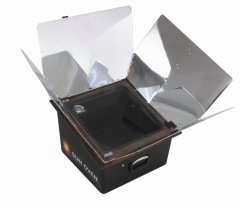
Although it is a hotter solar cooker, it is not always necessary that it be really hot to cook a lot of your recipes. Slower, longer and lower cooking conditions will produce more tender, moist and succulent dishes, and with the Sun Oven all you need to do is track your oven to the sun less often (frequently) to keep the temperatures more moderate if that is what you desire.
Cooking breads, cakes, pies, cobblers, cookies and any other baked goods is very simple and easy to accomplish with a Sun Oven because of it's capacity to achieve and maintain overall higher temps.
Because the Sun Oven has the capacity to incline to steeper angles without tipping the cooking vessel, the sun oven can be used all year around in many parts of the northern hemisphere. (The wintertime sun is much lower on the southern horizon, but the extension leg on the Sun Oven makes it easy to compensate for this and allows the oven to receive the rays of the sun more directly.)
For tips, suggestions and help using your Global Sun Oven
Tips for most effective use of your…Global Sun Oven (GSO)
- A new Sun Oven can have the smell of the newly manufactured and coated interior the first few times it is used. We recommend to all of our customers that the first time they use the GSO that they put it out in the sun with the cooking pot half full of water and a few drops of dish detergent, leaving it to steam for about five to six hours. Then, taking a dish rag and tongs, (very hot) wipe the whole interior of the solar oven to clean it out. This should help greatly with the smell. If need be, repeat the process another time.
Solar Oven Odor? - When using the Sun Oven on breezy days, it is a good thing to latch the reflector panels with the small wing-nut like device on the bottom panel so that the reflector panels are not bent when they catch a breeze. You might also give it more stability with bricks or wood pieces to prevent tipping in strong winds.
- Cooking a whole ham is easy to do in a Sun Oven by taking the leveling tray out and placing your ham into the oven wrapped inside of an oven cooking bag (turkey size).
- Most GSO's come with a round enamel cooking pot, but we have found that a mid-size, oval turkey roaster 15"x10"x6" can fit into the Sun Oven if placed on an angle, or sideways. This size of a roaster will increase your cooking volume capacity by a substantial amount; in fact two whole chickens can fit into it nicely.
- When cooking pies in the GSO (or any solar oven), we found that you can have a crisper crust if you bake the crust first, separate from the filling, and then the remaining half hour to hour of cook time, place the already cooking pie filling into the crust to finish the process.
- To better stabilize a tilted (leg extended) Sun Oven, you can have some block or brick supports to place under the solar oven on each side. This will help to prevent any spills or tipping of the oven on breezy days since the GSO can become a bit wobbly when the elevation leg is extended.
- For a steeper "winter time" angle on your Sun Oven, you can carefully turn the Sun Oven upside down so that it has greater inclination and can receive the rays of the sun more directly. Take out the swinging leveling tray before doing so.
- Treat the wood trim of your Sun Oven with commonly available wood oil in order to prevent the wood from drying and cracking. Do this every month or two when using the oven frequently.
- Wash out the interior of your Sun Oven with hot, soapy water every eight to twelve times of use, even if you do not spill anything in it. This will prevent odor and food condensation buildup.
- Do not leave an empty GSO heating in the sun for long periods of time without any food inside.
- Since the Sun Oven is not capable of using long, rectangular cookie or cake sheets, some people have increased the capacity by using square pans and double stacking them on an offset angle, thus virtually doubling their normal amounts. This technique will work better for some food items than for others since the lower or bottom pan will not always brown as well as the top; with cookies for example. But, when the top tray has browned and is finished you can remove it and allow the bottom cookies a few minutes longer to finish browning.
- Your Sun Oven, or any other solar box cooker, does not need to be used solely for cooking, but can be used for re-heating leftovers or keeping things warm after cooking. If you have ever planned a lunch of "yesterday's lasagna" and you know that at 12:30 you would like to have it ready to eat, just throw the food from the day before in to your solar cooker at 10:30 or 11:00 AM and it will be piping hot and ready to eat when you are.
- You can use your GSO to also sterilize medical instruments, pasteurize and sterilize unclean water for drinking, boil water for cleaning and bathing, sterilizing grains that may be infested.
- You can't fry foods in a solar oven, but you can come pretty close when cooking bacon or "frying" an egg. Lay out your bacon in strips and let them cook to the desired state, crunchy or soft, however you desire. The more you have the longer you should allow for cook time. You can also preheat oil or butter in a shallow, dark pan until it is as hot as the oven can reach, whereupon you crack an egg or two into the oil and then close the oven quickly to avoid heat loss, and within 3-6 minutes you will have a nicely "fried" egg.
Using a solar oven: The Solar Burner
The "Solar Burner" parabolic solar cooker is a different kind of solar cooker than the traditional box or panel style solar cooker, such as the Sport, GSO, and Hot Pot.
This cooker functions more like a stove top or range top burner, thus requiring one to be more attentive and requiring more hands on cooking as opposed to the more carefree functionality of a panel or box cooker. In other words it should be used like you would do so with a stove top.
The "Solar Burner" can be used for frying things such as fish, french-fries, scones etc. and it is also great for boiling pasta, potatoes, corn, veggies, etc.
Tips for most effective use of your… Solar Burner Parabolic
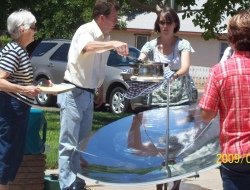
- A level terrain or surface; for stable positioning of your parabolic is a key to effective, safe and efficient cooking results. Avoid spills, accidents and such by assuring a level stable surface first. If you find your parabolic is still not quite level after having already started cooking, then remove the pan and make your adjustments before continuing with your cooking. This will assure a more secure and safe cooking environment and will be less likely to result in an accidental spill.
- When boiling or cooking large amounts of food try to use a lighter weight, yet thick metal cooking pot, in order to reduce the overall weight being placed on the pot receptacle (burner plate).
- When grilling items such as cheese sandwiches, pancakes or flour tortillas you will have better, more even cooking results if you can rotate or move your food from one side of the pan to the other every few seconds in order to prevent burning or scorching, since most solar cookers of this type do have a heat spot that is hotter overall. (cheese sandwiches take about three minutes max)
- When frying foods on your parabolic, it is recommended that you use the deepest pot available to you in order to prevent or reduce splattering of oil onto your parabolic panels. If you do splatter on the reflector panels, there is no real concern if you clean the panels with hot soapy water just as soon as you are finished with your frying. (If left for too many hours, the oil will congeal on the reflector panels, requiring hard scrubbing of the reflective surface, thus causing damage and scratching.
- It is helpful to keep a small table next to you when cooking on a parabolic so that you may have a place to set your pots and pans when stirring in other ingredients or to have where to lay your lids, utensils and such.
- It is much safer to mix in or add ingredients to your already cooking foods by removing your cooking vessel from the parabolic and doing so on a firm and more reachable surface. The parabolic will regain its cooking temperatures within seconds of returning the pots or pans to the pot receptacle after having removed it, thus minimizing the concern for lost cooking temperatures as with other styles of solar cookers.
- When boiling potatoes, or water for any other foods, it is not necessary to always adjust the parabolic as often as when frying or grilling since water will not burn or scorch, so you can leave the pot for up to fifteen minutes between checks. Granted, the more you "track" the sun the more concentrated the hot spot and the higher the temps, thus more rapid the results. * Note: Do not leave water or oil boiling unattended if there are children or others that might be put in danger by knocking them over.
- The parabolic is most effective when the panels are kept free of dust and food or water spots, this can usually be accomplished by keeping a soft rag to wipe the reflector panels down before or after each use. An even more effective and less likely method to cause scratching from fine dirt particles is to wash down your reflective surface with a hose or some warm water and then to dry it shortly afterward with a soft cloth to prevent water spots.
- Your parabolic can be a great tool for re-heating leftovers and is just as quick as using the stove top. Of course don't leave them too long or you will burn them. It only takes about two to five minutes to re-heat portions of leftovers.
- A parabolic solar cooker can be used to cook hot dogs directly in the heat of the concentrated rays of the sun, in other words it is not even necessary to use a pot or pan. Just place the hot dog on a stick and…voila, instant campfire-like hotdogs, or… your own solar hot dog cooker.
- This particular parabolic is designed using reflective adhesive vinyl strips not only for more even application and adhesion of the material to the metal panels, but also for ease of repair should a section of the reflective vinyl should be damaged or less reflective. You can replace the uniform adhesive strips easily in just minutes and have it looking like new again.
For tips, suggestions and help using your Solar Burner Parabolic
Great Video from one of our customers, Dennis Renner, on Stir fry with the Solar Burner
Find out more about how, where and when to solar cook.
How Solar Cooking Works
When to Solar Cook
Where you can Solar Cook
Winter Solar Cooking
Emergency Preparedness Solar Cooking
Canning with a Solar Cooker
Solar Oven Odor?
Here is how I have used my Solar Cooker
What Other Visitors Have Said
Click below to see contributions from other visitors to this page...
Recipe for Solar Oven Caribbean Beef Stew 




I've been requested to provide the recipe for the Caribbean Beef Stew that I posted last week, with my modifications for a solar cooker. It is from the …
Solar Oven Caribbean Beef Stew 




Today I decided to try my hand at making a recipe from my current issue of Food Network Magazine: Caribbean Beef Stew. It is originally for the slow …
Sort of Solar Baked Apples Not rated yet
Baked-ish Apples
Yesterday was left over day at our house, and I didn’t want to just try reheating in the Sun Oven, so I made my first dessert attempt. …
Return from Using a Solar Oven back to Home page

SOLAR COOKER CATEGORIES
Panel Cookers
Box Cookers
Parabolic Cooker
Evacuated Cookers
Accessories
Discontinued CookersNew Financing Options available for purchase of Solar Cookers

